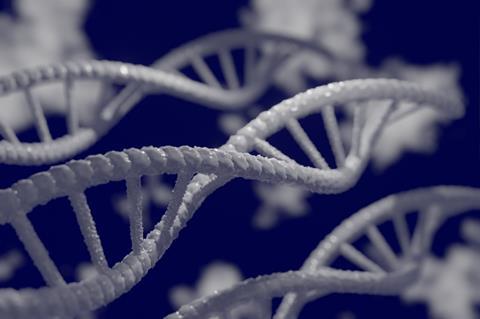A multidisciplinary study published in Nature has elucidated the structure of the machinery responsible for writing much of our “dark genome” — the 98 per cent of our DNA that has largely unknown biological function. These results may spur entirely novel treatments for autoimmune diseases, cancer and neurodegeneration.

An international team of scientists from Rutgers and more than a dozen other institutions, including both academia and industry, have published the first high-resolution images and structural details of a virus-like element known as LINE-1. They describe it as “an ancient genetic parasite” that is one of the most common parts of human DNA (video here). The research was led by Martin Taylor at Harvard Medical School and investigators at the biotechnology company ROME Therapeutics.
Jumping genes
Retroelements such as LINE-1 can act as “jumping genes” and have written a large fraction of our dark genome by a copy-and-paste mechanism. The vast majority of the half million LINE-1 elements in our genome are damaged — only about 100 LINE-1 elements have the potential to be active in our body’s cells.
Usually dormant in healthy cells, in disease, LINE-1 can break free and make proteins, including one called the LINE-1 ORF2 protein (L1 ORF2p) that attempts to add new mutation-causing copies of LINE-1 back into our DNA. Increased activity of the LINE-1 elements appears to be a common driver of autoimmunity, cancer, and other diseases.
Detailed knowledge of LINE-1, along with LINE-1 RNA and L1 ORF2p, may enable the discovery or creation of drugs that bind to one or more of these molecules and stop them from damaging the body, researchers said. It could also lead to fundamental discoveries about humans and other living things.
Reverse transcriptase
LINE-1 ORF2p functions as a reverse transcriptase. Professor Eddy Arnold, one of eight co-corresponding authors on the paper, and co-author Associate Research Professor Francesc Xavier Ruiz, both at Rutgers’ Center for Advanced Biotechnology and Medicine (CABM), are experts on the structure of reverse transcriptase enzymes.
“A central dogma of molecular biology held that genetic information always flowed from DNA to RNA to protein,” said Ruiz. “It wasn’t until the 1970s that reverse transcriptases were discovered — proteins like L1 ORF2p that make RNA into extra DNA, which is inserted into the genome — and that they were central to retroviruses such as HIV.”
Ruiz added: “The structures of HIV reverse transcriptase from the Arnold laboratory proved to be a critical turning point in designing novel medicines to combat the deadly virus, and now knowledge about the L1 ORF2p reverse transcriptase and how it works in our cells can be a similar turning point in fighting cancer, autoimmune diseases, or aging.”
Dark genome
LINE-1 is one of the most common elements in human DNA. A typical person’s genome contains more than half a million copies of the virus-like DNA. It is thus a major part of the “dark genome,” the poorly understood genetic material that doesn’t provide blueprints for any of the proteins that human bodies use.
Arnold, who holds equity in and has received consulting fees from ROME Therapeutics, helped to guide the structure determination efforts over the past four years, and he and Ruiz contributed to the study’s design and interpretation of results related to L1 ORF2p’s structure, function and evolution.
Arnold’s lab has been studying reverse transcriptase enzymes — the proteins that create DNA and try to insert it into host genomes — for more than 35 years. His lab’s discoveries about HIV reverse transcriptase structure and function guided the discovery of novel medications for HIV infection. Arnold said he also believes the mapping of L1 ORF2p’s structure could prove pivotal for biology as well as medicine.
Molecular machine
“As the paper explains, these analyses reveal the intricate workings of the molecular machine that has written nearly half of the human genome,” said Arnold, who is also a Board of Governors Professor and Distinguished Professor at both CABM and the Department of Chemical Biology. “The healthy body has mechanisms to repress these, but in disease states like cancers, these systems do not work properly. Through this amazing team effort, we now have a detailed understanding of how LINE-1 ORF2p works, which existing drugs do and do not work, and why. We also made major advances in our understanding of the evolution of these elements and how this may relate to viruses. All of this was only possible because of the highly collaborative and multidisciplinary team.”
Taylor said, “A key reason that we were able to make these advances is that we had an incredibly talented team with deep knowledge of structural biology and biochemistry of both mobile elements and viruses. We built on the foundation laid by decades of study of reverse transcriptases by Arnold lab and colleagues.”
Ruiz said these molecules “have an impact on us that goes way beyond diseases. For example, researchers have found out that insertion of these ’junk’ DNAs in the middle of the genes coding for the tail in hominids may explain why we no longer have tails.” Arnold added: “Indeed, the biological functions of the dark genome remain largely unknown, but clearly, activities there can shape who we are.”







No comments yet